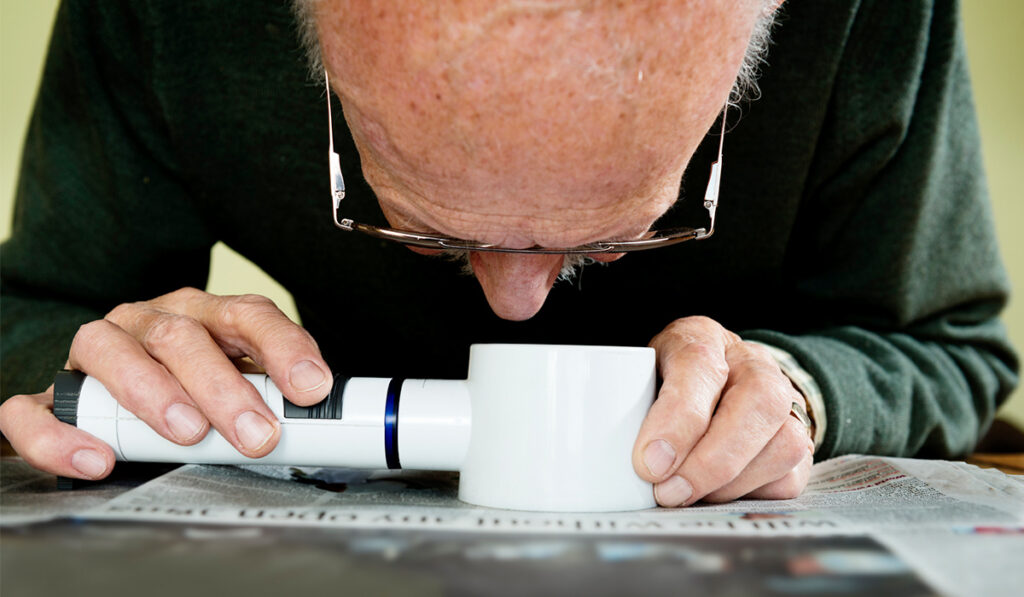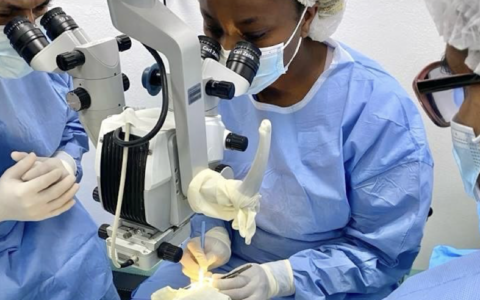Through participation in pivotal trials and real-world clinical application, new treatments for wet and dry age-related macular degeneration (AMD) are being evaluated.
For more than a decade, researchers at Vanderbilt Eye Institute addressed neovascular, or wet AMD (nAMD), via regular intravitreal injections of anti-vascular endothelial growth factor (VEGF) , known to slow the progression of choroidal neovascularization. Ongoing treatment is needed to maintain good visual acuity, with the potential for relapse and regression when treatment is stopped or when intervals are too long, said Avni Finn, M.D., a Vanderbilt retina specialist.
“We’ve been searching for more durable options,” Finn said. “And for dry AMD, we really haven’t had any treatments for decades – except offering patients the AREDS 2 vitamins. Now, we’ve made progress on both fronts.”
Longer-lasting Drugs
Because of the burden of monthly VEGF injections, many nAMD patients are undertreated and consequently lose vision, Finn says.
In a paper published in Drug Design, Development, and Therapy, Finn and Vanderbilt colleagues reviewed faricimab (VABYSMOTM), an injectable monoclonal antibody that inhibits both VEGF-A and angiopoietin 2. Faricimab was approved by the FDA in 2022 for the treatment of both nAMD and diabetic macular edema.
“Faricimab can potentially extend injections out to every four months instead of every one to two months in some patients,” Finn said. “For patients requiring frequent injections, it may fulfill an unmet need in terms of durability without compromising safety. Early real-world data are showing improved efficacy, as well.”
“Faricimab can potentially extend injections out to every four months instead of every one to two months in some patients.”
Vanderbilt researchers are involved in a separate trial testing high dose-aflibercept (EYLEA®), another drug that appears to be well-tolerated, to see whether injection intervals can be extended.
Promise of Gene Therapy
Finn says the treatment modality she’s most excited about for nAMD is gene therapy. An adenovirus-associated viral vector encoded with a gene to produce an antibody against VEGF is delivered via subretinal or intravitreal injection, thereby stimulating the patient’s own cells to make a VEGF-binding antibody.
“We have several patients enrolled in the ASCENT phase 3 trial of RGX-314 gene therapy. We’re monitoring them after treatment to see if they need injections; so far, we have not seen that.”
Another ongoing trial is testing gene therapy delivered via intravitreal injection, Finn says. “What we’ve seen as a retina community is that there’s a higher risk of inflammation or hypotony with intravitreal gene therapy.
“We worry about turning genes on that we can’t turn off again; I think that’s one of the hesitancies. Long-term data will be helpful to guide us to regarding safety concerns.”
New Treatment for Dry AMD
Finn says while many more patients have dry AMD than wet, ophthalmologists do not typically see these patients until they are near end-stage, when geographic atrophy has already occurred.
In February, the FDA approved pegcetacoplan (SYFOVRETM), the first treatment for dry AMD. Another agent could be approved in the coming year.
“These drugs act on the complement cascade that’s thought to be involved in the progression of dry macular degeneration – drusen under the retina and, in the later stages, the loss of cells,” Finn explained.
Finn and colleagues will be using autofluorescence and optical coherence tomography (OCT) to monitor geographic atrophy in patients eligible for treatment with pegcetacoplan.
“It’s the best way to measure if atrophy has slowed – patients are not going to have visual improvement with this new medication but may have less tissue loss over time.”
Imaging Research
The most important new research in the area of imaging is in home OCT monitoring, Finn says.
“If patients can do a home scan that is accurate and doesn’t send false signals, we can decrease patient burden and also catch disease early.”
Home OCT units would be distributed to people who have an intermediate or advanced version of dry macular degeneration. “These are patients where we’re worried about conversion from dry AMD to wet AMD; or one eye has converted and the other hasn’t,” Finn said.
Another high-reward area, she adds, is the development of artificial intelligence models for use with OCT to predict conversion or identify patients who are going to benefit the most from treatment.
“The ability to detect the precursors of AMD will allow us to begin treatment early and prevent irreversible vision loss,” Finn said.




